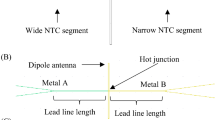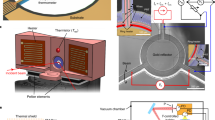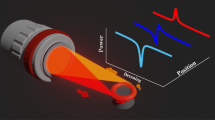Abstract
Existing infrared detectors rely on complex microfabrication and thermal management methods. Here, we report an attractive platform of low-thermal-mass resonators inspired by the architectures of iridescent Morpho butterfly scales. In these resonators, the optical cavity is modulated by its thermal expansion and refractive index change, resulting in ‘wavelength conversion’ of mid-wave infrared (3–8 µm) radiation into visible iridescence changes. By doping Morpho butterfly scales with single-walled carbon nanotubes, we achieved mid-wave infrared detection with 18–62 mK temperature sensitivity and 35–40 Hz heat-sink-free response speed. The nanoscale pitch and the extremely small thermal mass of individual ‘pixels’ promise significant improvements over existing detectors. Computational analysis explains the origin of this thermal response and guides future conceptually new bio-inspired thermal imaging sensor designs.
This is a preview of subscription content, access via your institution
Access options
Subscribe to this journal
Receive 12 print issues and online access
$209.00 per year
only $17.42 per issue
Buy this article
- Purchase on Springer Link
- Instant access to full article PDF
Prices may be subject to local taxes which are calculated during checkout





Similar content being viewed by others
Change history
11 July 2012
In the version of this Article originally published, the measured temperature difference ΔT was at the detector plane, whereas the definition of temperature sensitivity (NETD) in equation (2) requires ΔT to be a thermal scene temperature difference. Thus, the NETD terminology in equation (2) has now been replaced with temperature sensitivity (TS). This error has been corrected in the HTML and PDF versions of the Article.
References
Rogalski, A., Antoszewski, J. & Faraone, L. Third-generation infrared photodetector arrays. J. Appl. Phys. 105, 091101 (2009).
Taylor, S. J. & Morken, J. P. Thermographic selection of effective catalysts from an encoded polymer-bound library. Science 280, 267–270 (1998).
Webster, J. G. (ed.) The Measurement, Instrumentation, and Sensors Handbook (CRC Press, 1999).
Niklaus, F., Vieider, C. & Jakobsen, H. MEMS-based uncooled infrared bolometer arrays—a review. Proc. SPIE 6836, 68360D (2008).
LeMieux, M. C. et al. Polymeric nanolayers as actuators for ultrasensitive thermal bimorphs. Nano Lett. 6, 730–734 (2006).
McConney, M. E., Anderson, K. D., Brott, L. L., Naik, R. R. & Tsukruk, V. V. Bioinspired material approaches to sensing. Adv. Funct. Mater. 19, 2527–2544 (2009).
Singamaneni, S. et al. Bimaterial microcantilevers as a hybrid sensing platform. Adv. Mater. 20, 653–680 (2008).
Ostrower, D. Optical thermal imaging—replacing microbolometer technology and achieving universal deployment. III–Vs Review 19, 24–27 (2006).
Watts, M. R., Shaw, M. J. & Nielson, G. N. Microphotonic thermal imaging. Nature Photon. 1, 632–634 (2007).
Shenoi, R. V., Rosenberg, J., Vandervelde, T. E., Painter, O. J. & Krishna, S. Multispectral quantum dots-in-a-well infrared detectors using plasmon assisted cavities. IEEE J. Quantum Electron. 46, 1051–1057 (2010).
Dhar, N. K. Advances in micro-nano technologies for imaging sensors. SPIE Conference on Micro- and Nanotechnology Sensors, Systems, and Applications 7318, Keynote Presentation 7318-01 (2009).
Schmitz, H. Thermal characterization of butterfly wings—1. Absorption in relation to different color, surface structure and basking type. J. Therm. Biol. 19, 403–412 (1994).
Brown, B. R. Sensing temperature without ion channels. Nature 421, 495–495 (2003).
Haché, A. & Alloghoa, G.-G. Opto-thermal modulation in biological photonic crystals. Opt. Commun. 284, 1656–1660 (2011).
Klocke, D., Schmitz, A., Soltner, H., Bousack, H. & Schmitz, H. Infrared receptors in pyrophilous (‘fire loving’) insects as model for new un-cooled infrared sensors. Beilstein J. Nanotechnol. 2, 186–197 (2011).
Vukusic, P., Sambles, J. R., Lawrence, C. R. & Wootton, R. J. Quantified interference and diffraction in single Morpho butterfly scales. Proc. R. Soc. Lond. B 266, 1403–1411 (1999).
Kinoshita, S. & Yoshioka, S. (eds) Structural Colors in Biological Systems. Principles and Applications (Osaka University Press, 2005).
Kinoshita, S., Yoshioka, S., Fujii, Y. & Okamoto, N. Photophysics of structural color in the Morpho butterflies. Forma 17, 103–121 (2002).
Biró, L. P. & Vigneron, J. P. Photonic nanoarchitectures in butterflies and beetles: valuable sources for bioinspiration. Laser Photon. Rev. 5, 27–51 (2011).
Vukusic, P. Structural colour: elusive iridescence strategies brought to light. Curr. Biol. 21, R187–R189 (2011).
Guo, D., Lin, R. & Wang, W. Gaussian-optics-based optical modeling and characterization of a Fabry–Perot microcavity for sensing applications. J. Opt. Soc. Am. A 22, 1577–1588 (2005).
Golub, M. A., Hutter, T. & Ruschin, S. Diffractive optical elements with porous silicon layers. Appl. Opt. 49, 1341–1349 (2010).
Charrier, J. & Dribek, M. Theoretical study of the factor of merit of porous silicon based optical biosensors. J. Appl. Phys. 107, 044905 (2010).
Banerjee, S. & Dong, Z. Optical characterization of iridescent wings of morpho butterflies using a high accuracy nonstandard finite-difference time-domain algorithm. Opt. Rev. 14, 359–361 (2007).
Smith, G. S. Structural color of Morpho butterflies. Am. J. Phys. 77, 1010–1019 (2009).
Ding, Y., Xu, S. & Wang, Z. L. Structural colors from Morpho peleides butterfly wing scales. J. Appl. Phys. 106, 074702 (2009).
Yang, X., Peng, Z., Zuo, H., Shi, T. & Liao, G. Using hierarchy architecture of Morpho butterfly scales for chemical sensing: experiment and modeling. Sens. Actuat. A 167, 367–373 (2011).
Saranathan, V. et al. Structure, function, and self-assembly of single network gyroid (I4132) photonic crystals in butterfly wing scales. Proc. Natl Acad. Sci. USA 107, 11676–11681 (2010).
Saito, A. et al. Numerical analysis on the optical role of nano-randomness on the Morpho butterfly's scale. J. Nanosci. Nanotechnol. 11, 2785–2792 (2011).
Kambe, M., Zhu, D. & Kinoshita, S. Origin of retroreflection from a wing of the morpho butterfly. J. Phys. Soc. Jpn 80, 054801 (2011).
Driggers, R. G., Webb, C., Pruchnic, S. J. Sr, Halford, C. E. & Burroughs, E. E. Jr. Laboratory measurement of sampled infrared imaging system performance. Opt. Eng. 38, 852–861 (1999).
Ghiradella, H. Structure of butterfly scales: patterning in an insect cuticle. Microsc. Res. Tech. 27, 429–438 (1994).
Kinoshita, S. & Yoshioka, S. Structural colors in nature: the role of regularity and irregularity in the structure. Chem. Phys. Chem. 6, 1442–1459 (2005).
Potyrailo, R. A. et al. Morpho butterfly wing scales demonstrate highly selective vapour response. Nature Photon. 1, 123–128 (2007).
Potyrailo, R. A. Enhancement in screening throughput and density of combinatorial libraries using wavelet analysis. Appl. Phys. Lett. 84, 5103–5105 (2004).
Andrady, A. L. & Xu, P. Elastic behavior of chitosan films. J. Polym. Sci. B 35, 517–521 (1997).
Cheng, J. C. & Pisano, A. P. Photolithographic process for integration of the biopolymer chitosan into micro/nanostructures. J. Microelectromech. Syst. 17, 402–409 (2008).
Ogawa, Y., Hori, R., Kim, U.-J. & Wada, M. Elastic modulus in the crystalline region and the thermal expansion coefficients of alpha-chitin determined using synchrotron radiated X-ray diffraction. Carbohydr. Polym. 83, 1213–1217 (2011).
Zhang, Z., Zhao, P., Lin, P. & Sun, F. Thermo-optic coefficients of polymers for optical waveguide applications. Polymer 47, 4893–4896 (2006).
Gralak, B., Tayeb, G. & Enoch, S. Morpho butterflies wings color modeled with lamellar grating theory. Opt. Express 9, 567578 (2001).
Kinoshita, S., Yoshioka, S. & Kawagoe, K. Mechanisms of structural colour in the Morpho butterfly: cooperation of regularity and irregularity in an iridescent scale. Proc. R. Soc. Lond. B 269, 1417–1421 (2002).
Ingram, A. L. & Parker, A. R. A review of the diversity and evolution of photonic structures in butterflies, incorporating the work of John Huxley (The Natural History Museum, London from 1961 to 1990). Philos. Trans. R. Soc. Lond. B 363, 2465–2480 (2008).
Yoshioka, S. & Kinoshita, S. Wavelength-selective and anisotropic light-diffusing scale on the wing of the Morpho butterfly. Proc. R. Soc. Lond. B 271, 581–587 (2004).
Wagner, M., Wu, S. & Ma, E. Y. Pixel architecture for thermal imaging system. US patent 7,829,854 (2010).
TECHSPEC® Infrared Achromatic Lenses Provide Near Diffraction-Limited Focusing. Edmund Optics, posted 5 May 2011; available at http://optics.org/products/P000018926 (2011).
Korobkin, D., Urzhumov, Y. A., Zorman, C. & Shvets, G. Far-field detection of the super-lensing effect in the mid-infrared: theory and experiment. J. Mod. Opt. 52, 2351–2364 (2005).
Itkis, M. E., Borondics, F., Yu, A. & Haddon, R. C. Bolometric infrared photoresponse of suspended single-walled carbon nanotube films. Science 312, 413–416 (2006).
Zhang, Z., Xiao, G. Z., Zhao, P. & Grover, C. P. Planar waveguide-based silica-polymer hybrid variable optical attenuator and its associated polymers. Appl. Opt. 44, 2402–2408 (2005).
Donges, A. The coherence length of black-body radiation. Eur. J. Phys. 19, 245–249 (1998).
Tsai, C.-H. et al. Characterizing coherence lengths of organic light-emitting devices using Newton's rings apparatus. Org. Electron. 11, 439–444 (2010).
Acknowledgements
The authors would like to acknowledge J. Cournoyer and L. Denault for SEM and TEM imaging, M. Blohm, T. Leib, E. Hall and A. Linsebigler for encouragement, and N. Dhar for fruitful discussions. This work has been supported in part from DARPA contract W911QX-09-C-0062 “Bio Inspired IR Imaging” in 2009 and from General Electric's fundamental research funds. The views and conclusions contained in this paper are those of the authors and should not be interpreted as presenting the official policies or position, either expressed or implied, of DARPA or the US Government. Citation of manufacturers or trade names does not constitute an official endorsement or approval of the use thereof.
Author information
Authors and Affiliations
Contributions
A.D.P. designed, performed and analysed experiments, and wrote the manuscript. Y.U. performed thermal analysis. C.S. and W.G.M. assisted in conducting experiments and data analysis. A.V. and S.Z. performed optical simulations. T.D. assisted in the experimental design and preparation of the manuscript. H.T.G. provided guidance on experimental design and data interpretation. R.A.P. developed the concept, designed control experiments, analysed experimental data and assisted in preparation of the manuscript.
Corresponding author
Ethics declarations
Competing interests
The authors declare no competing financial interests.
Supplementary information
Supplementary information
Supplementary information (PDF 1230 kb)
Rights and permissions
About this article
Cite this article
Pris, A., Utturkar, Y., Surman, C. et al. Towards high-speed imaging of infrared photons with bio-inspired nanoarchitectures. Nature Photon 6, 195–200 (2012). https://doi.org/10.1038/nphoton.2011.355
Received:
Accepted:
Published:
Issue Date:
DOI: https://doi.org/10.1038/nphoton.2011.355
This article is cited by
-
Bioinspired Materials: From Distinct Dimensional Architecture to Thermal Regulation Properties
Journal of Bionic Engineering (2023)
-
Applications of bio-derived/bio-inspired materials in the field of interfacial solar steam generation
Nano Research (2022)
-
Dual wettability on diarylethene microcrystalline surface mimicking a termite wing
Communications Chemistry (2019)
-
A biomimicry design for nanoscale radiative cooling applications inspired by Morpho didius butterfly
Scientific Reports (2018)
-
Recent biomedical applications of bio-sourced materials
Bio-Design and Manufacturing (2018)



